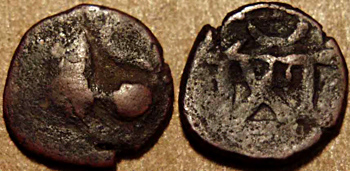 Emperor Ramagupta is considered as the supposed successor of Samudragupta. Initially Ramagupta was known from the traditional narratives. Later, three inscriptions on Jain Tirthankara images were discovered from Durjanpur near Vidisha district which mentions Ramagupta as the Maha Rajadhiraja. Many copper coins have been discovered from Vidisha region. The modern scholars became aware about the traditional accounts of Emperor Ramagupta, in 1923, when Sylvain Levi published some extracts of a Sanskrit play, named Devi Chandragupta which contains six quotations from this text. Natya Darpana.
Emperor Ramagupta is considered as the supposed successor of Samudragupta. Initially Ramagupta was known from the traditional narratives. Later, three inscriptions on Jain Tirthankara images were discovered from Durjanpur near Vidisha district which mentions Ramagupta as the Maha Rajadhiraja. Many copper coins have been discovered from Vidisha region. The modern scholars became aware about the traditional accounts of Emperor Ramagupta, in 1923, when Sylvain Levi published some extracts of a Sanskrit play, named Devi Chandragupta which contains six quotations from this text. Natya Darpana.
According to conventional records Ramagupta wanted to expand his kingdom by defeating the Sakas in Gujarat. The campaign was totally a failure and the Gupta army was trapped. The Saka king, Rudrasimha III, demanded that Ramagupta hand over his wife Dhruvadevi in exchange for peace. The weak king accepted these terms. Chandragupta went to the Saka camp by playing a trick, killed the Saka king and won the victory and also the esteem of the people and the queen. Later Ramagupta was overthrown and killed by his brother, who became Chandragupta II. Chandragupta II also married Dhruvadevi. In the play Devi Chandragupta authored by Visakhadatta, Ramagupta is portrayed as a weak and ineffective king who is terrified and incapable of fighting a battle.
Those who believe in the existence of Rama Gupta point out that these references come from different parts of India and belong to different periods and it cannot be considered as mere imagination. Those who are against this theory point out that in the epigraphs Chandra Gupta II was selected by his father for the throne, and, therefore the question of Rama Gupta becoming king after Samudragupta do not arise. If it is assumed that Rama Gupta captured the throne by force, then there would have been a civil war before Chandra Gupta would have submitted to him. Secondly, there is no inscription referring to Emperor Rama Gupta of the Gupta ancestors. A significant fact to be noted here is that none of the Gupta records clearly mentions that Chandragupta ends the rule of the Saka kings of Ujjayani, which is known from the evidence of coins only. Epigraphs evidently points to the fact that Chandragupta`s victory was not the outcome of a straight fight.
Prof. K. D. Bajpai`s view is that Rama Gupta was the elder brother of Chandragupta II or Vikramaditya. Some historians feel that Rama Gupta was not a member of the Imperial dynasty and flourished in the end of the fifth and the beginning of the sixth century A.D. in the remote regions of the Gupta Empire.



















